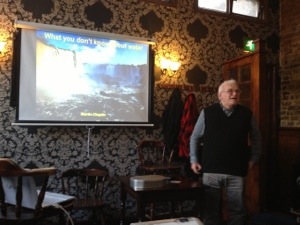Tags
(H2O)5, charge, conducts, crystals, flow, glass, gravity, H2O, homeopathy, hydrogen peroxide, Ice, ions, Martin Chaplin, memory, nanobubbles, pressure, pubsci, silica, solutes, temperature, water, weird
Controversy, thy name is PubSci. This evening we heard a talk by Professor Martin Chaplin on the remarkable properties of water. The talk started with some very unusual observations: firstly that liquid water contracts when heated, while most things expand; secondly that water molecules may move apart as the water density increases. It sounds counter-intuitive but there are good reasons for it.
Dr. Chaplin discussed the predictable instability of water: how the H2O bonds constantly break apart and form ion pairs, which last for mere milliseconds but 1 in every 60 water molecules exist as an ion pair at any one time. This allows water to form (H2O)5 molecular clusters, which break and re-form easily.
Dr. Chaplin showed that water behaves counter-intuitively in other ways too. At -100 degrees Celsius you get glassy structures, change the temperature or the pressure and crystals form. Water also behaves like two different substances depending on the pressure: at high pressure it behaves like other liquids; at low pressure it does not.
When electrically charged, water can defy gravity – creating a bridge between two bodies of water that flows one direction on the outside and the opposite direction on the inside. This is so odd it deserves its own paragraph and I can’t believe I almost forgot to add it.
Just like the subject of his talk, the talk itself got stranger as time went on. We covered nano bubbles (100 nm cavities in the water) and the Young-Laplace equation, why Nature Journal is convinced they don’t exist (Nature 2007, 445, 129) and how they can be measured and differentiated from dust particles using resonant mass measurement, dynamic light scattering, laser scattering, electrical resistance, and Brownian motion. Whilst I applaud any scientist who does not commit the Appeal to Authority fallacy and accept the findings of an established journal just because they said so, I did get the very strong feeling that a large part of his argument was an appeal to our fondness for the underdog up against the establishment – or what I call Dr. Jack Horner syndrome.
My suspicions were borne out as the subject turned to “water having memory”. The basis given for this statement was that when you stir one of two identical glasses of water, you can tell which one was stirred by examining the chemical composition of it. Glass dissolves so the stirred glass will have minutely higher traces of silica in it than the unstirred glass. If you stirred it long enough you would have hydrogen peroxide. At this point an audience member asked whether she could produce enough hydrogen peroxide to dye her hair – to which Dr. Chaplin replied that her hair would be white by the time she finished. Another audience member brought up the point that all matter in the universe has “memory” by this definition and that his insistence in the case of water was some sort of fetish on his part.
What intrigued me about Dr. Chaplin’s presentation style was that he defended elements of the validity of homeopathy without believing in homeopathy itself. I would very much like to see a presentation made by him in front of a pro-homeopathy crowd to see how different it is. I think Chaplin really enjoys goading people and that comes across strongly in his performance.
He raised some interesting questions at the end: whether the binary state of H2O / ion pair could be responsible for the memory of living organisms in the same way that binary switches work in computing; and whether the states of water could be integral to our understanding of cancer – in cancer cells the water tends to be more fluid.
A fascinating and engaging talk, even though I felt I was being coerced into agreeing with him at times (projection slide labelled “closed mind or water has memory”), which is always a turn-off.
Come along next month – we’re either talking about: debunked alien babies; 1960’s spaceballs; or swimming robots depending on the timetable of the speakers. Whatever the topic, science + beer = good.

